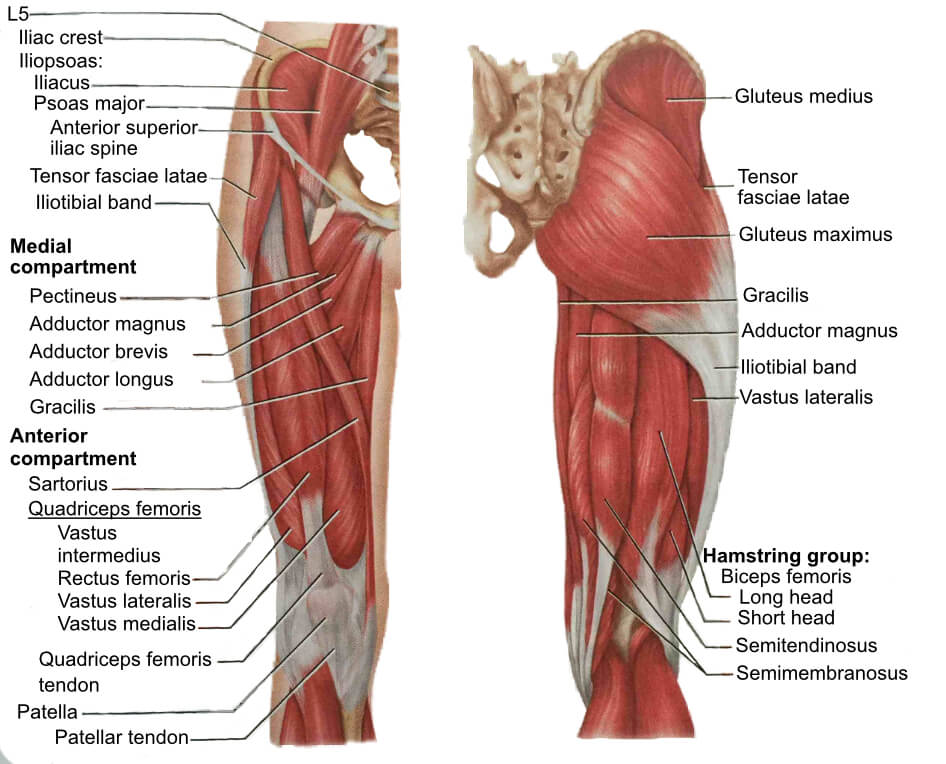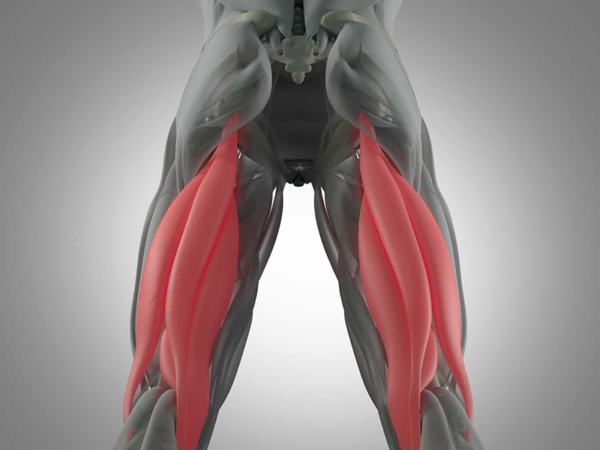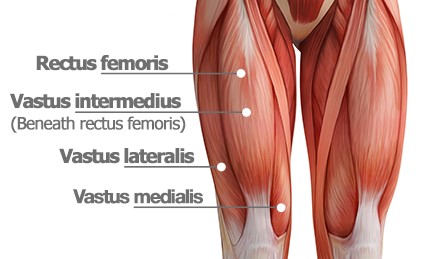Upper leg and hip pain: Causes, Symptoms, and Treatment
In this article, you’ll learn more about common hip and upper leg issues such as osteoarthritis, piriformis syndrome, hamstring injuries, quadriceps problems, and adductor strains.
Why upper leg and hip pain is increasing
Pain in the hip, groin, and upper leg is becoming more common, partly due to our increasingly sedentary lifestyles. Long periods of sitting leave our hips and legs in the same position, reducing movement and muscle activation. This lack of mobility can lead to stiffness, tightness, and muscle weakness.
When we then engage in complex and demanding activities like squats or running—often without proper warm-ups or muscle activation—it can cause significant problems.
Hip and upper leg issues often affect surrounding areas too. For example, hip problems are commonly linked to lower back or knee pain. Maintaining strong and functional hips is crucial for a healthy, mobile body.
Understanding the Anatomy
The leg is composed of:
- Thighbone, kneecap, lower leg bones (shinbone and calf bone), and foot
- Joints: Hip, knee, ankle, and foot joints
The gluteal muscles primarily act on the hip joint, facilitating hip movement. The upper leg muscles (hamstrings, quadriceps, and adductors) influence both the hip and the knee.
A well-balanced interaction between these muscles and joints forms the foundation for strength, endurance, and mobility. When this balance is disrupted, pain and discomfort can arise.


Common hip injuries
Hip Osteoarthritis
Hip osteoarthritis (coxarthrosis) is a common condition where the cartilage in the hip joint gradually wears down. While this process occurs naturally, it doesn’t always cause symptoms. When it does, it often leads to stiffness in the groin area and pain when initiating movement.
Treatment focuses on strengthening the hip muscles, particularly through rotational exercises. This stimulates the joint capsule to produce lubricating fluid, improving mobility.
Snapping hip
A snapping hip refers to a clicking or popping sensation in the hip during forward or sideways movements. This occurs when a muscle, tendon, or ligament slides over a bony prominence in the hip.
- Often caused by tightness in the iliopsoas tendon or hip ligaments.
- Can also involve the gluteus maximus or the iliotibial band on the side of the thigh.
- At the back of the hip, it’s usually the hamstring tendon snapping over the joint.
Piriformis syndroom
Piriformis syndrome involves compression of the sciatic nerve by the piriformis muscle, causing symptoms such as:
- Tingling and pain in the buttocks, upper leg, knee, or calf
- Lower back pain
- Difficulty sitting for extended periods
- Numbness in the buttocks and upper leg
Causes include overuse, prolonged sitting, hip instability, or a misaligned sacroiliac (SI) joint. Treatment begins with a thorough diagnosis to address the root cause.



Upper Leg Pain
Thigh issues generally fall into three categories: hamstring, quadriceps, and adductor injuries. Since we rely on our legs so much, these problems can significantly impact daily life.
- Acute injuries often heal on their own with controlled movement and rest.
- Chronic or gradual-onset issues usually require professional assessment and treatment.
If symptoms last longer than a week, it’s wise to consult a physiotherapist. We identify the root cause and provide targeted solutions.
Hamstring INJURIES
A hamstring injury is the most common type of thigh injury. Acute hamstring injuries often occur when sprinting or due to overstretching. Over time, hamstrings can also become progressively tighter and stiffer.
The hamstrings are located at the back of the thigh, running from your sit bone to your shinbone and fibula. They are responsible for knee flexion, hip extension, and knee rotation. The knee rotation function of the hamstrings is often overlooked.
Gradual hamstring pain is often less about the hamstrings themselves and more about other parts of your body. With the amount of time we spend sitting in a flexed position, many people have weak or underactive stretch chains in their body. The hamstrings are part of this chain, connected from your neck to your toes. If one part of the chain is weak or dysfunctional, the hamstrings will compensate, leading to stiffness and tightness.
In this case, stretching or foam rolling your hamstrings won’t resolve the issue. What helps more is strengthening your hamstrings, calves, and back muscles. This way, you can achieve more flexibility without directly stretching your hamstrings! The best exercises for your hamstring depend on the underlying cause. Feel free to ask one of our physiotherapists for advice.
Chronic hamstring issues could also be linked to nerve problems. Read more about nerve-related issues here.
Quadriceps issues
The quadriceps consists of four muscle heads, one of which crosses both the hip and the knee, while the other three only cross the knee. Together, these four heads allow the hip to flex and the knee to extend. Along with the hamstrings, the quadriceps form a powerful muscle pair for both flexion and extension. Issues or stiffness in one can lead to problems or maintain issues in the other. Therefore, it’s important to conduct a thorough investigation into the underlying mechanisms of an injury.
Acute quadriceps injuries often occur when sprinting or during other explosive movements, or due to a bruise or trauma to the muscle, such as from a fall or a kick. These injuries usually heal within 6-8 weeks.
Chronic quadriceps issues include conditions like jumper’s knee or patellar tendon injuries. In these cases, the patellar tendon is under prolonged high tension, leading to irritation.
Problems with the quadriceps can also cause knee pain, hip pain, back pain, and patellofemoral pain syndrome.


Adductor Injuries
Adductor issues are located on the inner side of the thigh.
There are two adductor muscles that run from the pubic bone toward the hip and pelvis, and four that run from the pubic bone toward the thigh and knee. A key function of the adductors is stabilizing the hip. In addition, the adductors assist with hip flexion, extension, and rotation.
Acute adductor injuries often occur during sprints or rapid side-to-side movements, leading to a strain or muscle tear.
Adductor problems can also develop gradually and worsen over time. This typically happens when there’s an imbalance in the surrounding muscles of the thigh. As a result, the adductors overcompensate and become overburdened. This can manifest as stiffness and radiating pain along the inner thigh or locally in the groin area. The adductors are often very tender when pressed.
Issues with the adductors can also cause problems elsewhere in the body, such as knee pain, hip pain, and back pain. It’s important to thoroughly examine the underlying mechanism of adductor injuries.
Our Approach to Treatment
Effective treatment starts with identifying the underlying cause of your pain. For acute injuries, the source is often clear. Chronic issues, however, may involve multiple factors.
Our approach includes:
- Comprehensive assessment of your movement patterns, history, and any contributing injuries.
- Examination of surrounding joints and muscles, including the back, pelvis, knees, and feet.
- Targeted treatment using a combination of manual therapy, Active Release Techniques, and customized exercises.
